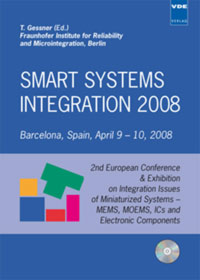An electromagnetic energy harvester for low frequency excitation
Conference: Smart Systems Integration 2008 - 2nd European Conference & Exhibition on Integration Issues of Miniaturized Systems - MOMS, MOEMS, ICS and Electronic Components
04/09/2008 - 04/10/2008 at Barcelona, Spain
Proceedings: Smart Systems Integration 2008
Pages: 8Language: englishTyp: PDF
Personal VDE Members are entitled to a 10% discount on this title
Authors:
Hohlfeld, Dennis; Vullers, Ruud; Boeck, Jo de (Holst Centre / IMEC-NL, Eindhoven, The Netherlands)
Abstract:
We propose and demonstrate an electromagnetic energy scavenging scheme which can harvest energy from non-harmonic motion. It is especially designed to operate on large amplitudes and low frequency excitation while simultaneously bearing the potential for microfabrication. A permanent magnet is employed as an inertial mass which generates a flux change in an arrangement of coils. The coils are interconnected in such a way as to provide a periodic voltage signal. Miniaturized electromagnetic scavengers are based on resonant mechanical systems which amplify small input displacements into useful vibration amplitudes. The applicability of these systems is limited to the bandwidth of their mechanical resonance. These systems typically target operating frequencies of several 100 Hz. Miniaturized resonant systems can hardly be designed for frequencies lower than 50 Hz; e. g. encountered in human body motion or long stroke machine operation. This is due to the fact that the required mechanical parameters, as high mass and low suspension stiffness, conflict with the dimensions of the miniaturized system. The presented scavenger design taps into the low frequency regime where excitation occurs with stroke amplitudes of a few millimeters. The device does not require a mechanical resonator for amplitude amplification. A miniature permanent magnet is placed in an oblong recession. Due to its inertia it can slide freely under displacement of the substrate. Additional permanent magnets are located at the ends of the channel acting as magnetic springs.


